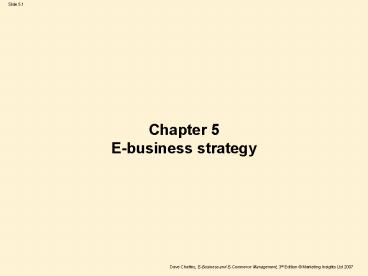Chapter 5 Ebusiness strategy - PowerPoint PPT Presentation
1 / 35
Title:
Chapter 5 Ebusiness strategy
Description:
Michael Porter on the Internet ... Porter, M. (2001) Strategy and the Internet, Harvard Business Review, March 2001, 62 78. ... Porter's five forces. Slide 5.21 ... – PowerPoint PPT presentation
Number of Views:1137
Avg rating:3.0/5.0
Title: Chapter 5 Ebusiness strategy
1
Chapter 5E-business strategy
2
Learning outcomes
- Follow an appropriate strategy process model for
e-business - Apply tools to generate and select e-business
strategies - Outline alternative strategic approaches to
achieve e-business.
3
Management issues
- How does e-business strategy differ from
traditional business strategy? - How should we integrate e-business strategy with
existing business and IS strategy? - How should we evaluate our investment priorities
and returns from e-business?
4
Michael Porter on the Internet
- The key question is not whether to deploy
Internet technology companies have no choice if
they want to stay competitive but how to deploy
it.
Porter, M. (2001) Strategy and the Internet,
Harvard Business Review, March 2001, 6278.
5
Alternative definitions of strategy
- What is strategy?
- Defines how we will meet our objectives
- Sets allocation of resources to meet goals
- Selects preferred strategic options to compete
within a market - Provides a long-term plan for the development of
the organization.
6
Figure 5.1 Different forms of organizational
strategy
7
Sell-side E-commerce strategy (Chapters 8 9)or
E-marketing/E-CRM Strategy
- Sell-side e-commerce is a channel strategy
- Objectives for online contribution percentage
should drive our strategy - Our e-commerce strategy defines how we should
- Hit our channel leads sales targets
- Acquisition, Conversion, Retention, Service,
Profitability - Communicate benefits of using this channel
- Prioritise products available through channel
- Prioritise audiences targeted through channel
- Select partners for this channel
- Channel strategy thrives on differentials
- BUT, need to manage channel integration.
8
Buy-side E-commerce strategy (Chapters 6 7)or
E-supply chain management strategy
- Buy-side e-commerce strategy is about maximizing
operational efficiencies while improving customer
service quality - Operational efficiency KPIs should drive our
strategy - Our buy-side e-commerce strategy defines how we
should - Automate internal processes
- Link internal resource management systems with
external purchasing systems - Prioritize suppliers/partners collaborating using
this channel - Prioritize applications for E-SCM create a
roadmap - Involves selection of appropriate strategic
partners.
9
E-business strategy
- For me, an IS strategy or change management
strategy (Chapter 10) which ensures resources are
managed effectively to achieve opportunities from
Buy-side and Sell-side e-commerce. Also involves
deploying IS to manage administrative internal
process and employee knowledge - Involves management of information systems
resources (e-business applications,
infrastructure/hardware and people/change/
knowledge management).
10
Figure 5.2 Relationship between e-business
strategy and other strategies
11
What happens where there is no e-business
strategy?
- Missed opportunities for additional sales on the
sell-side and more efficient purchasing on the
buy-side - Fall-behind competitors in delivering online
services may become difficult to catch-up, e.g.
Tesco, Dell - Poor customer experience from poorly integrated
channels.
12
Figure 5.3 BA communicates their online value
proposition (www.britishairways.com) Source
Based on Revolution (2005)
13
Figure 5.4 A generic strategy process model
14
Figure 5.5 Dynamic e-business strategy
model Source Adapted from description in
Kalakota and Robinson (2000)
15
Figure 5.6 Elements of strategic situation
analysis for the e-business
16
Figure 5.7 Summary applications of a portfolio
analysis for The B2B Company
17
Figure 5.8 SWOT analysis for The B2B Company
18
Figure 5.9 Customer demand for e-marketing
services for The B2B Company
19
Figure 5.10 Competitive threats acting on the
e-business
20
Porters five forces
21
Activity impact of Internet
- For one of the industries below, assess how the
Internet has changed the competitive forces, e.g.
has it increased or decreased power of suppliers
and customers - Industries
- Banking
- Supermarkets
- Oil industry
- Rail industry
22
Figure 5.11 Elements of strategic objective
setting for the e-business
23
Figure 5.12 An evaluation tool relating
information to business value. An organizations
use of information on each axis can be assessed
from 1 (low useof information) to 10 (high use
of information) Source Marchand et al. eds (1999)
24
Figure 5.13 Capital One web site
(www.capitalone.co.uk)
25
Figure 5.14 Direct and indirect Internet
contributions for fast-growth companies inthe
USA Source PricewaterhouseCoopers (2000)
26
Figure 5.15 Grid of product suitability against
market adoption for transactionale-commerce
(online purchases)
27
Table 5.5 Vision of online revenue contribution
for The B2B Company
28
Figure 5.16 Elements of strategy definition for
the e-business
29
Figure 5.17 Strategic options for a company in
relation to the importance of the Internet as a
channel
30
Right Channelling
- Right channelling can be summarized as
- Reaching the right customer
- Using the right channel
- With the right message or offering
- At the right time
- Examples
- B2B serve SMEs through e-channels and larger
clients through personal service - Encourage consumers to buy and serve through
lower cost electronic channels - Encourage offline fulfillment/conversion as
appropriate - Different levels of service/promotion for
different customers.
31
Figure 5.18 Liveperson an example of a service
to assist with right-channelling Source
www.liveperson.com
32
Figure 5.19 Using the Internet to support
different growth strategies
33
Figure 5.20 smile (www.smile.co.uk) Source
Reprinted by permission of The Co-operative Bank
34
Figure 5.21 Dabs.com (www.dabs.com)
35
Figure 5.22 Elements of strategy implementation
for the e-business































